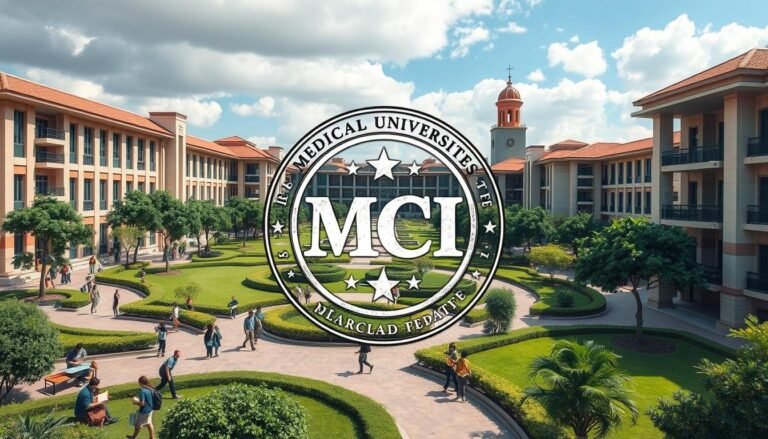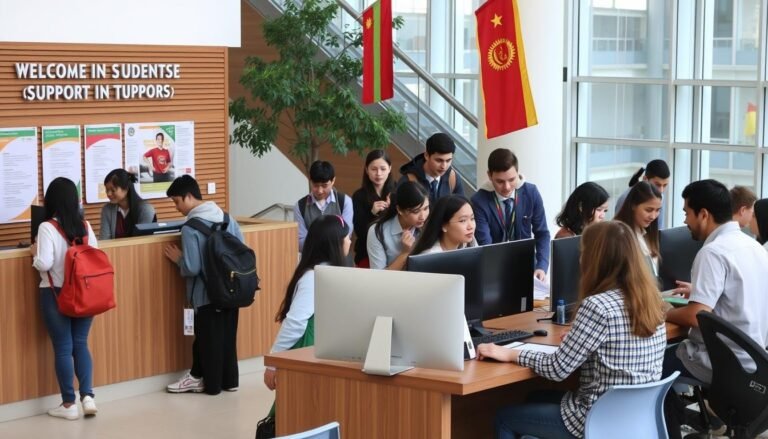MBBS Teaching System in Uzbekistan Medical Universities: A Comprehensive Guide
Curious about medical education in Uzbekistan? This guide explores the MBBS teaching system in top Uzbek medical universities. We’ll uncover innovative teaching methods and state-of-the-art facilities.
Uzbekistan’s medical degrees are globally recognized. Discover why pursuing an MBBS here could be your ideal educational path.

Overview of Medical Education in Uzbekistan
Uzbekistan is a top choice for aspiring medical students. The country boasts 706 medical colleges with over 106,000 seats. Its education system focuses on practical training and meets international standards.
Current State of Medical Universities
Uzbekistan’s medical universities are globally recognized for their advanced education system. The curriculum emphasizes practical exposure and internships. Students gain hands-on experience to become skilled healthcare professionals.
Recognition and Accreditation
Prestigious global bodies accredit Uzbekistan’s medical universities. These include the World Health Organization (WHO) and the Foundation for Advancement of International Medical Education and Research (FAIMER). The National Medical Commission (NMC) of India also recognizes these institutions.
This recognition ensures high-quality medical training. It also guarantees the international credibility of Uzbekistan’s medical degrees.
Educational Standards and Quality
Uzbekistan’s medical education system uses a competency-based assessment approach. This ensures students develop essential knowledge, skills, and attitudes for quality healthcare. The curriculum meets global standards.
Universities actively collaborate with international partners. This ongoing effort improves the quality of uzbekistan medical universities.
Uzbekistan MBBS Teaching Method
Uzbekistan’s MBBS program spans six years, offering thorough medical education. It includes five years of classroom learning and one year of clinical training. This approach ensures students gain a comprehensive understanding of medicine.
The program emphasizes problem-based learning. Students engage in discussions, analyze real medical cases, and develop critical thinking skills. This method helps apply theory to practical scenarios, preparing them for future challenges.
Uzbekistan medical universities use an integrated curriculum. This approach connects various disciplines, fostering a deeper understanding of healthcare. Students learn about the human body, diseases, and treatments holistically.
Extensive clinical rotations are a key feature of the MBBS program. Students gain hands-on experience in diverse medical settings. These include hospitals, clinics, and specialized simulation labs.
This practical training equips students with essential skills and confidence. It prepares them to navigate the complexities of the medical field effectively.
Uzbekistan’s MBBS teaching method is innovative and well-rounded. It empowers students to become competent and compassionate healthcare professionals.
Modern Teaching Infrastructure and Facilities
Uzbekistan’s medical universities offer top-notch infrastructure for MBBS students. They have advanced medical simulations and labs. Students get hands-on training with the latest medical tech.
Simulation Labs and Training Centers
These universities have invested in cutting-edge simulation labs. Students practice medical procedures using high-fidelity patient simulators. This helps them develop clinical skills safely.
The labs use technology-enhanced learning tools. Students can hone their abilities without risking patient safety.
Clinical Training Facilities
Uzbekistan’s medical schools partner with leading hospitals. These modern teaching facilities offer real-world clinical experience. Students observe and assist under expert guidance.
Digital Learning Resources
The universities embrace digital learning. Students access virtual libraries and interactive multimedia content. These tools keep them updated on medical advancements.
Uzbekistan’s MBBS program combines hands-on training with digital resources. It prepares students for successful healthcare careers.
English-Medium Instruction System
Uzbekistan’s medical universities now use English as the main teaching language. This change helps international students, including those from India. It removes language barriers and prepares students for global medicine. Universities also teach basic Uzbek to help with patient talks during clinical rotations.
The English-medium system allows students to learn without language problems. It helps students talk with patients from different cultures. This skill is useful during training and future medical work.
International teachers at Uzbekistan’s medical schools add to the learning experience. They bring world views to the lessons. Students learn about different medical practices and research methods. This knowledge helps them in the ever-changing world of healthcare.
| Feature | Uzbekistan Medical Universities |
|---|---|
| Medium of Instruction | English with Uzbek language courses for patient interactions |
| International Faculty | Experienced professionals from diverse backgrounds |
| Cross-Cultural Learning | Students gain exposure to global medical practices and research |
| Preparation for Global Medical Practice | English-medium instruction and cross-cultural communication skills |
Uzbekistan’s medical schools create a diverse, global learning space. They teach in English and welcome international staff. This approach gives students the tools to succeed in worldwide healthcare.
Clinical Training and Practical Experience
Uzbekistan’s MBBS curriculum focuses on early clinical exposure and hands-on training. Students undergo regular hospital rotations to gain experience in patient care. This helps them develop crucial clinical skills for their future careers.
Hospital Rotations
Students participate in extensive hospital rotations as part of their medical education. They apply theoretical knowledge in real-world clinical settings. These rotations allow students to observe professionals and engage in patient interactions.
Students also gain insight into hospital operations. This experience is vital for their future medical practice.
Patient Interaction Opportunities
Uzbekistan’s MBBS program takes a patient-centered approach. Students have many chances to interact with patients and improve their communication skills. They learn to address concerns, gather medical histories, and provide appropriate care.
Hands-on Clinical Skills Development
The curriculum emphasizes hands-on clinical skills development. Students participate in simulation-based training to practice essential medical procedures. They learn to take vital signs, perform examinations, and administer treatments in a safe environment.
This practical approach prepares students for real medical practice. It equips them with the skills and confidence to provide high-quality, patient-centered care after graduation.
Innovative Learning Approaches
Uzbekistan’s medical universities lead in innovative teaching methods. They focus on critical thinking and problem-solving skills. Students from diverse backgrounds benefit from these new approaches.
Case-based learning is a key innovation in the curriculum. Students analyze real-world clinical scenarios and develop treatment plans. This method applies theory to practical situations, preparing students for modern healthcare.
Interprofessional education is another innovative approach. Medical students work with peers from nursing and pharmacy. This collaboration promotes a holistic view of patient care.
Interactive teaching methods like simulations enhance learning. Students practice clinical skills in a safe environment. These approaches prepare future healthcare professionals for evolving medical demands.
Student Assessment and Evaluation Methods
Uzbekistan’s medical universities use a thorough system to assess students. It includes ongoing evaluations, skill-based tests, and performance tracking. This approach ensures students are tested on both theory and practice regularly.
The goal is to promote steady learning and improvement. Students receive constant feedback to help them grow and understand better.
Continuous Assessment Systems
Our medical programs have regular assessment checkpoints. These include written tests, practical exams, and project-based evaluations. Students are often tested on their grasp of course material.
Frequent feedback helps them spot areas for growth. It also strengthens their understanding of the subject.
Competency-Based Evaluation
Our universities also use skill-based evaluation. This method focuses on developing and testing critical clinical skills. These include patient examination, diagnostic reasoning, and treatment planning.
Students must show they can use their knowledge in real-world scenarios. This practical approach prepares them for actual medical practice.
Performance Tracking Methods
Our schools use methods to track student progress over time. These monitor academic performance, clinical skills, and professional growth. This data-driven approach helps identify strengths and weaknesses.
It allows for targeted support and guidance. Students can get help where they need it most.
| Assessment Method | Description | Frequency |
|---|---|---|
| Written Tests | Evaluate students’ theoretical knowledge and understanding of course material | Regularly scheduled throughout the program |
| Practical Examinations | Assess students’ clinical skills and ability to apply their knowledge in hands-on scenarios | Conducted at the end of each clinical rotation |
| Project-Based Evaluations | Measure students’ critical thinking, problem-solving, and collaborative skills through group or individual projects | Assigned throughout the program |
| Competency Assessments | Evaluate students’ mastery of essential clinical competencies, such as patient examination, diagnosis, and treatment planning | Integrated throughout the curriculum |
| Performance Tracking | Monitor students’ overall academic performance, clinical skills, and professional development | Continuous throughout the program |
International Faculty and Expertise
Uzbekistan’s medical universities have a diverse faculty with global experience. They work with top institutions worldwide, improving education and research for students. This collaboration enhances the overall learning experience.
Samarkand State Medical University (SSMU) leads in global partnerships. SSMU has attracted talented faculty from around the world. These experts bring new teaching methods and vast knowledge to students.
- SSMU’s international faculty hail from leading medical institutions in the United States, Europe, and Asia, ensuring students receive a truly global perspective on healthcare.
- Regular faculty development programs at SSMU keep instructors up-to-date with the latest advancements in medicine and education, enabling them to provide cutting-edge instruction to their students.
- The university’s commitment to international collaborations has resulted in research partnerships and joint projects with prestigious medical schools, expanding the horizons of both faculty and students.
Uzbekistan’s medical universities offer a unique blend of global expertise. They combine experienced faculty, international collaborations, and faculty development programs. This mix creates an inspiring learning environment for future healthcare professionals.
| University | QS World University Ranking | Recognized by | International Faculty Ratio |
|---|---|---|---|
| Samarkand State Medical University | 5692 | NMC, WHO, FAIMER | 40% |
| Tashkent Medical Academy | 5510 | NMC, WHO, FAIMER | 35% |
| Bukhara State Medical Institute | 8963 | NMC, WHO, FAIMER | 25% |
Research Opportunities and Academic Resources
Zarmed University offers medical students in Uzbekistan numerous research opportunities. Students can access state-of-the-art facilities and learn from experienced faculty. The university’s commitment to excellence is evident in its comprehensive curriculum.
The curriculum covers basic sciences, clinical skills, ethics, and various medical subjects. Students gain a solid foundation for their medical careers. Clinical rotations provide hands-on training in real healthcare settings.
Students can participate in advanced medical research at Zarmed University. They develop critical thinking skills and contribute to medical knowledge. The university has advanced labs, simulation centers, and medical libraries.
| Research Opportunities | Academic Resources |
|---|---|
| Participation in medical research projects Collaboration with faculty on research initiatives Presentation of research findings at conferences Publication opportunities in peer-reviewed journals | Modern, well-equipped libraries Access to online databases and e-journals State-of-the-art simulation laboratories Cutting-edge medical training facilities |
Zarmed University’s faculty includes experienced clinicians, researchers, and educators. They’re trained by Apollo MedSkills to provide high-quality instruction. Students receive guidance throughout their studies.
The university emphasizes interdisciplinary learning. It partners with nursing, pharmacy, and public health programs. This approach enhances the holistic nature of the medical education experience.
Zarmed University focuses on evidence-based medicine. It prepares students for successful medical careers. The university provides the tools, resources, and opportunities for students to excel in academics and research.
Cultural Integration and Support Systems
Uzbekistan’s universities offer international students a multicultural learning environment. They provide support systems to help students adapt to local culture and excel academically.
Students join orientation programs upon arrival. These introduce them to Uzbekistan’s history, traditions, and customs. Such programs foster cross-cultural understanding and prepare students for unique experiences.
Language support services ensure effective communication with locals. These include intensive courses and tutoring. Cultural activities like festivals and excursions immerse students in Uzbekistan’s vibrant heritage.
The diverse student body and faculty create an inclusive learning environment. Students can share their cultural perspectives and learn from each other. This global experience makes Uzbekistan’s medical universities attractive to international students.
- Language support services, including intensive language courses and tutoring, ensure that students can effectively communicate and engage with the local community.
- Cultural integration activities, such as festivals, cultural excursions, and student clubs, enable international students to immerse themselves in Uzbekistan’s vibrant cultural heritage.
- The multicultural student body and faculty create a diverse and inclusive learning environment, where students can share their own cultural perspectives and learn from one another.
| Initiatives | Description |
|---|---|
| Orientation Programs | Introduce international students to Uzbekistan’s rich history, traditions, and customs |
| Language Support Services | Intensive language courses and tutoring to improve communication skills |
| Cultural Integration Activities | Festivals, cultural excursions, and student clubs to immerse in local culture |
| Multicultural Learning Environment | Diverse student body and faculty promote cross-cultural understanding |
Conclusion
Uzbekistan’s medical universities offer top-notch MBBS education recognized worldwide. The curriculum is innovative and practical, making Uzbekistan an attractive destination for international students. It provides quality training in a supportive, multicultural setting.
These universities boast world-class facilities and modern teaching infrastructure. MBBS programs are taught in English, removing language barriers for foreign students. Hands-on clinical training and rigorous assessments prepare graduates for global success.
Studying MBBS in Uzbekistan is cost-effective due to low living expenses. Institutions like Axis Institute provide comprehensive support to students. Graduates can practice medicine or continue education worldwide, opening numerous opportunities.





